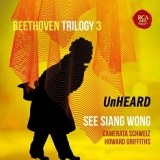Der Schweizer Pianist See Siang Wong beendet mit Unheard seine Beethoven-Trilogie bei RCA. Auf dem dritten Album sind unvollendete Werke von Beethoven zu hören. Den Auftakt macht die Sonate op. 109. Dieses Opus ist zwar als 30. Sonate vollendet bekannt, aber hier handelt es sich um eine neue Alternativversion, die Jörg Wyttenbach aus Beethovens Skizzenbüchern, zusammenstellte. Diese enthält viel Neues und Bekanntes in anderer Form, so dass eine wirklich interessante neue Version zustande kam, die See Siang Wong mit großer Sensibilität und einer berührenden Intimität spielt, als wolle er mit diesen angereicherten Skizzen bescheiden und taktvoll in Beethovens ureigene Privatsphäre eindringen.
Nicht weniger interessant ist die Komposition in D-Dur, über die See Siang Wong sagt: « Man sieht dem Manuskript an, dass sich Beethoven mit diesem Werk intensiv beschäftigt hat. Es enthält viele Kommentare zu seinen musikalischen Ideen sowie zahlreiche Korrekturen und Spielvarianten. Dieses unvollendete Werk des jungen Beethoven gehört in meinen Augen zu den wegweisendsten und spannendsten aus dieser Schaffensperiode. » Das von Wong fertiggestellte zweisätzige Werk ist in der Tat unüberhörbar Beethoven und wird vom jungen Pianisten wirkungsvoll interpretiert.
Es folgt das Allegro eines D-Dur-Konzerts, das der Musikwissenschaftler Guido Adler 1888 entdeckte und Beethoven zuschrieb. Neueren Erkenntnissen zufolge soll der Satz aber eher vom böhmischen Komponisten Jan Joseph Rösler (1771-1812) stammen. Das Stück wird von der Camerata Schweiz unter Howard Griffiths sehr vital gespielt, und See Siang Wong hat genug Stilgefühl und musikalischen Geschmack, um seinen Part so zu gestalten, dass das fein nuancierte und inspirierte Spiel komplett natürlich wirkt und den Hörer berührt, wo andere Pianisten vielleicht eher auf vordergründig-virtuosen Glanz gesetzt hätten.
Von Beethovens Klavierkonzert Nr. 6 gibt es nur einen einzigen erhaltenen Satz, ein Allegro, das hier in der Aufführungsversion von Nicholas Cook und Kelina Kwan aus dem Jahre 1986 erklingt, die ihrerseits von Hermann Dechant überarbeitet und mit einer neuen Coda bereichert wurde. See Siang Wong hat seinerseits, wie für das Rösler-Konzert, eine eigene Kadenz komponiert.
Auch dieses Konzert wird spannend und attraktiv dargeboten, so dass man, nach dem schönen Albumblatt am Ende sagt: Hier ist nicht nur ein anziehendes Programm zu hören, dieses wird auch auf musikalischen auf hohem Niveau gespielt, das unzweifelhaft zeigt, was für ein technisch versierter, hoch musikalischer Pianist See Siang Wong ist.
Swiss pianist See Siang Wong completes his Beethoven trilogy for RCA with Unheard. The third album features unfinished works by Beethoven. This opus is known as the 30th completed sonata, but this is a new alternative version that Jörg Wyttenbach has compiled from Beethoven’s sketchbooks. This contains much that is new and familiar in a different form, resulting in a really interesting new version, which See Siang Wong plays with great sensitivity and a touching intimacy, as if he wanted to modestly and tactfully enter Beethoven’s very own private sphere with these enriched sketches.
No less interesting is the composition in D major, about which See Siang Wong says: « You can tell from the manuscript that Beethoven worked intensively on this work. It contains many comments on his musical ideas as well as numerous corrections and variations. In my opinion, this unfinished work by the young Beethoven is one of the most groundbreaking and exciting from this creative period. » The two-movement work completed by Wong is indeed unmistakably Beethoven and is interpreted effectively by the young pianist.
It is followed by the Allegro of a D major concerto, which the musicologist Guido Adler discovered in 1888 and attributed to Beethoven. According to more recent findings, however, the movement is more likely to have been written by the Bohemian composer Jan Joseph Rösler (1771-1812). The piece is played with great vitality by the Camerata Schweiz under Howard Griffiths, and See Siang Wong has enough sense of style and musical taste to shape his part in such a way that the finely nuanced and inspired playing seems completely natural and touches the listener, where other pianists might have opted for superficial virtuoso brilliance.
There is only one surviving movement of Beethoven’s Piano Concerto No. 6, an Allegro, which is performed here in the 1986 version by Nicholas Cook and Kelina Kwan, which in turn was revised by Hermann Dechant and enriched with a new coda. See Siang Wong has composed his own cadenza, as he did for the Rösler concerto.
This concerto is also performed in an exciting and attractive manner, so that, according to the beautiful album cover at the end, one can say: not only is an attractive program to be heard here, it is also played at a high musical level, which undoubtedly shows what a technically accomplished, highly musical pianist See Siang Wong is.






















